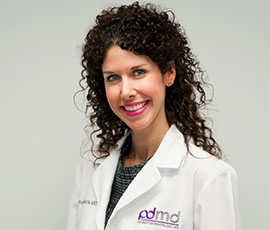Give cold sores the cold shoulder
We've all seen someone with it. Or maybe you've got it yourself. The dreaded cold sore on the corner of the lip. It warns you it's coming with a tingling and burning feeling, then the painful blisters arrive and often outstay their welcome. So what's the deal with these cold sores? Where do they come from?
A virus called herpes simplex virus (HSV) is responsible for causing cold sores, also referred to as fever blisters. It most commonly occurs in young adults, but can be seen at any age, including infancy. Many people are infected with the virus and never develop cold sores. Others may have sores but they aren't painful or symptomatic. And yet others will have fever, headache, or pain associated with the blisters.
80-90% of herpes infections seen on the lips are caused by HSV type 1, and 10-20% are caused by HSV type 2. Genital herpes is usually reversed, with 70-90% caused by HSV-2, and 10-30% caused by HSV-1. But this is not a hard and fast rule; either type can be seen with lips or genitals.
So how is this virus spread? Usually skin-skin contact is required. The virus is shed in skin or secretions. When herpes is seen in wrestlers due to skin-to-skin contact, it's called herpes gladiatorum, and is more common on the head, neck, or shoulder.
Unfortunately, once you've contracted HSV, it's there for life. (So what happens in Vegas doesn't always stay in Vegas...). It stays dormant in the nerves and gets reactivated later on. About 1/3 of people with cold sores on the lips will have a recurrence. And of these, 1/2 will have at least two recurrences annually. Usually there is a precipitating factor to bring it out: sunburns/sun exposure, fevers/colds, stress, and altered hormones.
Before we discuss treatment, let's talk prevention. Avoid skin-to-skin contact with an area during an outbreak. The outbreaks are usually treated with oral antiviral medications such as acyclovir, valcyclovir (valtrex), or famciclovir. If the outbreaks are very frequent, daily suppressive therapy may be used. There are topical presciption creams, as well, but they are typically not as effective as the pills. The medications work best if they're used as soon as the tingling/burning feeling comes on. Although there's no cure, with today's treatments, the discomfort can be minimized and sometimes prevented.
Categories
- November 2014 (1)
- December 2014 (3)
- January 2015 (4)
- February 2015 (3)
- March 2015 (1)
- April 2015 (3)
- May 2015 (4)
- June 2015 (2)
- July 2015 (0)
- August 2015 (1)
- September 2015 (2)
- October 2015 (4)
- November 2015 (1)
- December 2015 (1)
- January 2016 (2)
- February 2016 (1)
- March 2016 (3)
- April 2016 (2)
- May 2016 (1)
- June 2016 (1)
- August 2016 (1)
- October 2016 (1)
- January 2017 (1)
- February 2017 (1)
- June 2017 (1)
- August 2017 (1)
- October 2017 (1)
- December 2017 (1)
- April 2018 (1)
- May 2018 (1)
- November 2018 (1)
- May 2019 (1)
- July 2019 (1)
- January 2020 (1)
- March 2020 (2)
- July 2020 (1)
- November 2020 (0)
- January 2021 (1)
- October 2021 (1)
- January 2022 (1)
- June 2022 (1)
- November 2022 (1)
- April 2023 (1)
- September 2023 (1)
- September 2023 (1)
- December 2023 (1)
- February 2024 (1)
- July 2024 (1)
- September 2024 (1)
- March 2025 (1)
- October 2025 (1)
Archives
Latest on blog
The fountain of youth: collagen!
Published September 30th, 2025These days, everyone is searching for the elusive Fountain of Youth. But dermatologists know what...
Learn More
